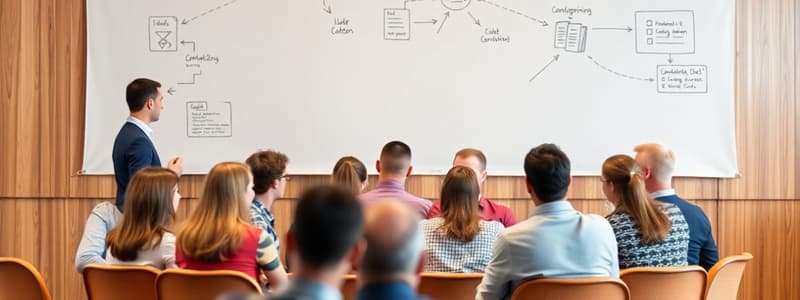Podcast
Questions and Answers
What is the primary goal of HR policies as emphasized in the content?
What is the primary goal of HR policies as emphasized in the content?
- To communicate and interpret policies for all employees
- To convince line managers of their necessity and equip them for implementation (correct)
- To avoid involvement with union representatives
- To ensure policies are implemented solely by upper management
Which group is identified as having a key role in the implementation of HR policies?
Which group is identified as having a key role in the implementation of HR policies?
- Front line managers (correct)
- Union representatives alone
- Upper management only
- Human Resources department exclusively
Which action is NOT part of the process for formulating HR policies?
Which action is NOT part of the process for formulating HR policies?
- Consulting with employees via surveys
- Seeking views from union representatives
- Communicating policies with guidance notes
- Drafting policies based solely on management’s opinions (correct)
What aspect is emphasized regarding the implementation of HR policies?
What aspect is emphasized regarding the implementation of HR policies?
When gathering views on HR policies, which method is suggested for employee feedback?
When gathering views on HR policies, which method is suggested for employee feedback?
What is a primary function of HR policies in relation to corporate values?
What is a primary function of HR policies in relation to corporate values?
Which of the following best describes a disadvantage of formalized HR policies?
Which of the following best describes a disadvantage of formalized HR policies?
How can HR policies influence organizational culture?
How can HR policies influence organizational culture?
What is one reason smaller organizations may choose to formalize HR policies?
What is one reason smaller organizations may choose to formalize HR policies?
Which of the following is an important aspect of HR policies supporting business strategy?
Which of the following is an important aspect of HR policies supporting business strategy?
What aspect primarily defines power orientation in organizational culture?
What aspect primarily defines power orientation in organizational culture?
Which orientation emphasizes the importance of hierarchy and legitimacy?
Which orientation emphasizes the importance of hierarchy and legitimacy?
How do HR policies contribute to organizational culture?
How do HR policies contribute to organizational culture?
What is a key characteristic of task orientation?
What is a key characteristic of task orientation?
Which orientation suggests that the organization primarily serves the needs of its members?
Which orientation suggests that the organization primarily serves the needs of its members?
In what way do HR policies impact employee motivation?
In what way do HR policies impact employee motivation?
What can be a consequence of poorly developed HR policies within an organization?
What can be a consequence of poorly developed HR policies within an organization?
Which category emphasizes task accomplishment and the authority of knowledge?
Which category emphasizes task accomplishment and the authority of knowledge?
Flashcards
Purpose of HR Policies
Purpose of HR Policies
HR Policies guide how to handle employee matters while aligning with company values. They help to implement and demonstrate company values, guide decision-making, and empower employees.
Policy Flexibility
Policy Flexibility
Formalized policies, though consistent, can sometimes be seen as inflexible or constricting.
Policy Benefits
Policy Benefits
Formal policies provide consistency in dealing with people issues within an organization. They can also help with employee induction and understanding the organization's philosophy and values.
Policy Relevance
Policy Relevance
Signup and view all the flashcards
Policy Adaptability
Policy Adaptability
Signup and view all the flashcards
HR Policy Formulation
HR Policy Formulation
Signup and view all the flashcards
Employee Feedback
Employee Feedback
Signup and view all the flashcards
Line Manager Role
Line Manager Role
Signup and view all the flashcards
Policy Communication
Policy Communication
Signup and view all the flashcards
HR's Role
HR's Role
Signup and view all the flashcards
Organizational Culture
Organizational Culture
Signup and view all the flashcards
Power Orientation
Power Orientation
Signup and view all the flashcards
Role Orientation
Role Orientation
Signup and view all the flashcards
Task Orientation
Task Orientation
Signup and view all the flashcards
People Orientation
People Orientation
Signup and view all the flashcards
HR Policies
HR Policies
Signup and view all the flashcards
HR Policy Purpose
HR Policy Purpose
Signup and view all the flashcards
HR Policy Impact
HR Policy Impact
Signup and view all the flashcards
Study Notes
HRM Techniques II - Unit 1
- Organizational Culture: A pattern of values, norms, beliefs, and assumptions that shape how people and organizations behave.
- It's not dynamic and constantly changing
- It's multi-dimensional and challenging to define precisely
- Leaders form the culture, through visionaries
- Culture develops from effective relationships and creates values/expectations
- Culture is influenced by the environment
- There can be variations of cultures within organizations in different departments
- Organizational cultures have different components, including:
- Values (beliefs about what's good for the organization)
- Norms (unwritten rules on how to behave)
- Artefacts (tangible aspects like environment, tone, language)
- Leadership style (e.g., charismatic, enabling, autocratic, transactional)
HRM Techniques II - Unit 1, Organizational Culture Continued
- Classifying organizational culture: Different models for classifying cultures exist (Harrison, Handy, Schein, Williams, Dobson & Walters)
- Harrison: Power-orientated, People-orientated, Task-orientated, Role-orientated
- Handy: Power, Role, Task, Person
- Schein: Power, Role, Achievement, Support
- Williams, Dobson and Walters: Power, Role, Task, Person
HRM Techniques II - Unit 2
- HR Policies: Continuing guidelines for how the organization manages its people.
- Define philosophies and values on how people should be treated
- Establish principles for managers when handling personnel matters.
- HR policies are written guidance for diverse situations
- Purpose of HR policies: Support cultures of trust, fairness, and inclusion. Impacts talent attraction and retention, employee motivation. Supports sustainable performance
- Formalization of HR policies: Useful in induction, team leader/management training and communicating policies within the organization.
- Reason for introducing/reviewing policies: Internal change, reflecting legislation, to support business strategy, following latest developments in employee management, to comply with head office policy, operating in wider markets
HRM Techniques II - Unit 3
- HR Policy Areas: Overarching policy that encompasses varied specific policies.
- Issues covered include substance abuse, equal opportunity, age and employment, managing diversity, promotion, employee development, work/life balance, new technologies, health & safety, sexual harassment, bullying and employee relations.
- Formulating and implementing policies:
- Understanding corporate culture & values
- Analyzing existing policies (written, unwritten, implicit)
- Assessing external influences (national/EU legislation, professional codes)
- Gathering manager and employee feedback
- Consulting with unions
- Developing draft policies
- Approving and communicating policies (with training materials)
- Implementing policies requires the participation of line managers.
HRM Techniques II - Unit 4
- Communication in Companies: Communication happens between employees, company parts, and managers.
- Communication process: Sender → Encoding → Message → Decoding → Receiver
- Types of communication: Downward (management to employees), upward (employees to management), horizontal (collaboration between different parts within an organization)
- Informal communication: Communication without strict formal channels (e.g., gossip).
- Importance of communication for organizational success: Building a transparent & positive culture, engaging employees regarding organizational priorities, empowerment/involvement, improving employee retention/motivation
- Forms of communication:
- Formal networks (chain, wheel, Y, circle, star)
- Informal networks (gossip, clusters)
HRM Techniques II - Unit 5
- Case Study: Nestlé HR Policies: Focus is on policies to manage people in a large global organization.
- Additional data on this topic is required for further study.
Studying That Suits You
Use AI to generate personalized quizzes and flashcards to suit your learning preferences.




